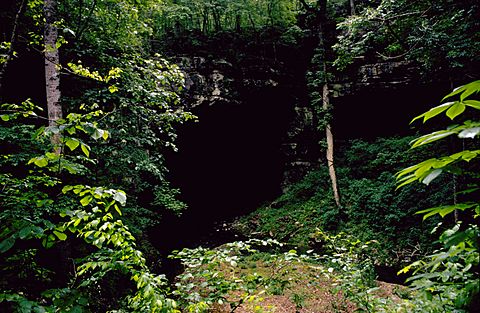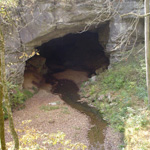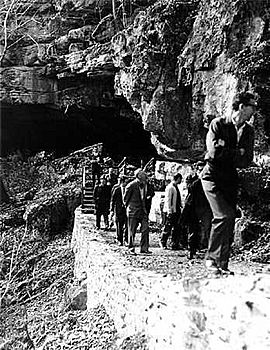Russell Cave National Monument facts for kids
Quick facts for kids Russell Cave National Monument |
|
|---|---|
|
IUCN Category III (Natural Monument)
|
|
 |
|
| Lua error in Module:Location_map at line 420: attempt to index field 'wikibase' (a nil value). | |
| Location | Jackson County, Alabama, United States |
| Nearest city | Bridgeport, Alabama |
| Area | 310 acres (130 ha) |
| Created | May 11, 1961 |
| Visitors | 20,717 (in 2011) |
| Governing body | National Park Service |
| Website | Russell Cave National Monument |
| Designated: | October 15, 1966 |
| Reference #: | 66000150 |
Russell Cave National Monument is a special place in northeastern Alabama, United States. It's near the town of Bridgeport. This monument was created on May 11, 1961. The National Geographic Society gave 310 acres (about 1.3 square kilometers) of land to the American people. Now, the National Park Service takes care of it. Russell Cave was added to the National Register of Historic Places on October 15, 1966.
Russell Cave has a very large main entrance. For thousands of years, Native Americans used this cave as a shelter. They lived here from about 6500 BCE until 1650 CE. This was around the time Europeans started settling in America. People believe the cave was mostly used as a warm winter home. The people found food, tools, and wood in the nearby forest. You can take guided tours to see the shelter area today.
Russell Cave is the third-longest mapped cave in Alabama, stretching 7.2 miles (11.6 kilometers). It's also one of the longest caves in the United States and the world. You can no longer go caving inside Russell Cave. However, there are trails for walking outside. The area is also a stop on the North Alabama Birding Trail, which is great for birdwatching.
Contents
How Did Russell Cave Form?
The rock that makes up Russell Cave formed over 300 million years ago. Back then, this area was covered by a shallow, tropical sea. Tiny sea creatures' skeletons and shells slowly turned into limestone. Over time, rainwater mixed with carbon dioxide from the air. This made the water slightly acidic. This acidic water slowly dissolved parts of the limestone rock, creating the cave.
About 9,000 to 12,000 years ago, a sinkhole opened up near Doran's Cove. This happened when a cavern roof collapsed underground. This collapse exposed Russell Cave, making it accessible.
At first, a large stream filled the entire cavern, making it hard to live in. But a rockfall from the cave ceiling changed the stream's path. This opened up a dry part of the cave floor. The first people lived on this uneven rock floor. Over many years, dirt and debris from people living there, plus things falling from the ceiling, raised the floor. The floor eventually rose 7 to 8 feet (2.0 to 2.5 meters) in some spots. Near the upper entrance, it rose up to 30 feet (9.0 meters). In the 1960s, after the cave was dug up, workers added long bolts to stop more rock from falling.
The main cave entrance faces east. This helps block cold winds from the north and northwest. It also lets in the warm morning sun. The cave has five other entrances besides the main one. A natural spring flows into the cave. This water travels underground for 1.5 miles (2.5 kilometers) before joining Widow's Creek and then the Tennessee River.
Who Lived in Russell Cave?
Early People: The Archaic Period (Before 1000 BCE)
This amazing place tells us about thousands of years of human history. We know people started living in Russell Cave almost 10,000 years ago. They were hunter-gatherers from the Archaic period in the southeastern United States. We know this from charcoal found from their campfires. The oldest fires date back to between 6550 and 6145 BCE.
These people likely used the cave mostly in autumn and winter. This was when they needed more shelter from the cold. Evidence like deer bones and passenger pigeon remains suggests they were there in colder months. The cave also provided a constant source of water because it stayed above freezing.
The surrounding forest and the nearby Tennessee River provided food all year. They ate fish, turtles, and shellfish. They also hunted birds like wild turkey and small mammals like squirrels and raccoons. Men also hunted larger animals like deer and black bears. Women gathered nuts, seeds, and roots. They used mortars and pestles to grind nuts.
These early cave dwellers were very good at using everything from the animals they hunted. Women cooked the meat. They also prepared animal hides to make clothing. Bones were shaped into tools.
Their main weapon was a short spear with a stone point. They threw these spears using an atlatl, which is a throwing stick. The stone points were made from chert, a type of rock found near the cave. Chert was also used for knives and scrapers. They made awls and needles from bones. These were used to make clothes and baskets. Small bone pieces were also used to make fish hooks.
Changes Over Time: The Woodland Period (1000 BCE to 500 CE)
Around 1000 BCE, the tools used by Native Americans at Russell Cave changed a lot. This was the start of the Woodland period. For the first time, we find pottery. Smaller weapon points show that the bow and arrow had replaced the atlatl. Bone tools became more refined. Other tools suggest that people started gardening at the site. Also, people began to use bone and shell for decorations.
During this period, people hunted more. It seems the cave became more of a hunting camp. When they weren't at the cave, they probably lived in larger summer villages. These changes happened across the eastern United States. During the Woodland period, people also started building earthwork burial mounds. The population grew, and trade became more important.
The style of pottery also changed. Early pottery had fabric patterns, while later pottery had patterns made by carved wooden paddles.
Later Visitors: The Mississippian Period (After 500 CE)
After the Woodland period, around 500 CE, Native Americans used Russell Cave less and less. Sometimes, small groups of hunters would visit and leave behind objects different from earlier times. These visitors were mound builders from the Mississippian culture. They came from permanent villages where they farmed successfully. They built large earthwork mounds for their religious and political beliefs. The last people to regularly use the cave left around 1000 CE.
Recent History of the Cave
Centuries later, Cherokee Indians lived in this part of the Tennessee Valley. They and the European settlers who came later didn't use the cave much. As permanent towns grew, places like Russell Cave were only used sometimes, usually by hunting or trading groups. Few modern items were found close to the surface. Only one modern item, a metal fishing hook, was found.
The Spanish explorer Hernando de Soto passed within 100 miles (160 kilometers) of Russell Cave in 1540.
Russell Cave is named after Colonel Thomas Russell. He was a soldier from the American Revolutionary War who owned the land when maps were made. The land around it, Doran's Cove, is named after Major James Doran, who was Colonel Russell's brother-in-law and the first owner. After the cave was explored in 1956, the National Geographic Society bought the land. They then gave it to the American people. The area became a National Monument in 1961, when John F. Kennedy was president.
What We Learned from Russell Cave: Archeological Discoveries
Russell Cave has given us some of the best records of prehistoric cultures in the southeastern United States. Archeologists have found about two tons of artifacts here! These include charcoal from fires, animal bones (from hunted animals and used as tools), spear and arrow points, pieces of pottery, and the remains of several adults and children buried in the cave floor. The bodies were buried in shallow pits and had no objects buried with them.
The first items were found in 1953. Four people from the Tennessee Archeological Society and the University of Tennessee at Chattanooga started digging in the cave. This first dig went down about six feet (1.8 meters).
When they realized how important the site was, they contacted the Smithsonian Institution. The Smithsonian worked with the National Geographic Society for three seasons (1956–1958) of digs. They dug down more than 32 feet (9.8 meters)! In 1962, the National Park Service did another dig, going down 10.5 feet (3.2 meters). This final dig completed the records and helped create an exhibit at the site.
Studying the tools found shows that there were very few non-weapon tools compared to weapons. This suggests that Russell Cave was mainly a hunting camp, not a place where people lived all year round. The information we have from Russell Cave helps us understand a part of prehistoric life, but it's not the whole story.
Animals and Plants at Russell Cave
Studies of the land and plants show that the flora (plants) and fauna (animals) of the Eastern Forest Region stayed mostly the same for thousands of years. This started to change after European-American settlers arrived in the early 1800s. They cut down trees for timber and to clear land for farming.
The cave is home to brown bats and northern long ear bats. The cave stream has fish called sculpin. Snakes in the area include the copperhead, timber rattlesnake, rat snake, and kingsnake. Over 115 types of birds have been seen at Russell Cave. It's part of the North Alabama Birding Trail. Bones of porcupines and peccaries have been found in the cave, even though these animals are not found in this area today.
Visiting Russell Cave National Monument
Russell Cave National Monument is located at 3729 County Road 98, Bridgeport, Alabama 35740. It's open all year, seven days a week. It's closed on New Year's Day, Thanksgiving Day, and Christmas Day. The hours are 8:00 am to 4:30 pm Central Time. There are no fees to enter the park or tour the cave.
There are many things to see and do at Russell Cave National Monument.
Gilbert H. Grosvenor Visitor Center
At the visitor center, you can see exhibits and watch films about how prehistoric people lived. There's also a gift shop and bookstore. The visitor center is named after Gilbert Hovey Grosvenor. He was the editor of National Geographic Magazine for many years and president of the National Geographic Society. The center was dedicated in 1967.
Exploring the Cave Shelter
Guided tours of the cave shelter are led by National Park Service Interpretative Rangers. The cave shelter is where the prehistoric groups lived. It has a diorama that shows what life was like for the people there. The cave shelter is about 300 yards (300 meters) from the visitor center. You get there by walking on an elevated wooden boardwalk.
Russell Cave: A Unique System
Russell Cave is one of Alabama's largest cave systems, with over seven miles (11 kilometers) of mapped tunnels. You can't go caving here anymore. This is because several rare species have been found inside, including a type of scorpion found nowhere else in the world. If you're interested in caving, you can ask the visitor center for the latest information.
Walking Trails
Russell Cave National Monument has two trails for visitors. The Nature Trail is 0.6 miles (0.95 kilometers) long and paved. The Backcountry Trail is 1.2 miles (1.9 kilometers) long and a dirt path. Both trails are great for seeing the forest, wildflowers, and Montague Mountain. Along the trails, you'll find signs about plants that Native Americans used for food, tools, and other daily needs.
Native American Festival
Every year, during the first weekend in May, Russell Cave National Monument hosts a Native American Festival. The festival includes storytelling, dancing, and Native American flute playing. There's also a historical reenactment of a Cherokee camp. At this event and other times, you can see demonstrations of Native American life and weapons. These include flintknapping (making arrowheads), using an atlatl for spear throwing, and using a bow and arrow. Other demonstrations show wood carving, making pottery by hand, and fire building.
North Alabama Birding Trail
Russell Cave National Monument is Site 44 on the Northeastern Loop of the North Alabama Birding Trail. This "trail" isn't a walking path. It's a series of places in North Alabama that are great for birdwatching.
Many types of birds can be seen here. The site is known for its tanagers (summer tanager and scarlet tanager) and the yellow-billed cuckoo. During bird migration, you might spot almost any type of eastern warbler and vireo. The best times to see songbirds are in spring, summer, and autumn.
Images for kids











